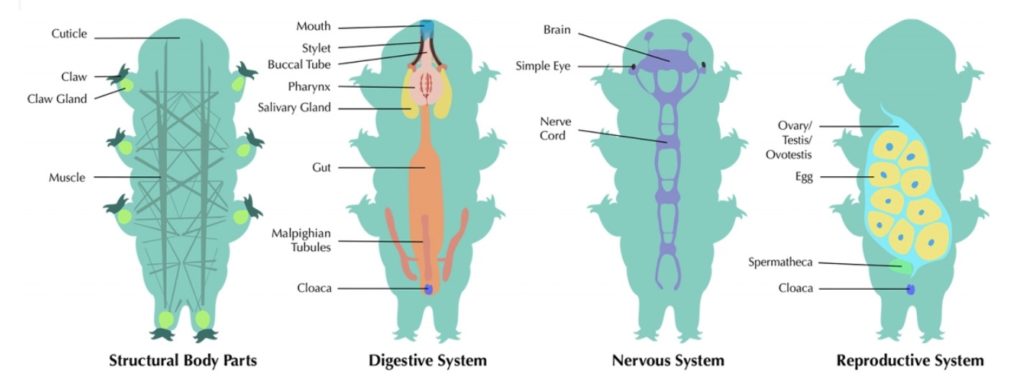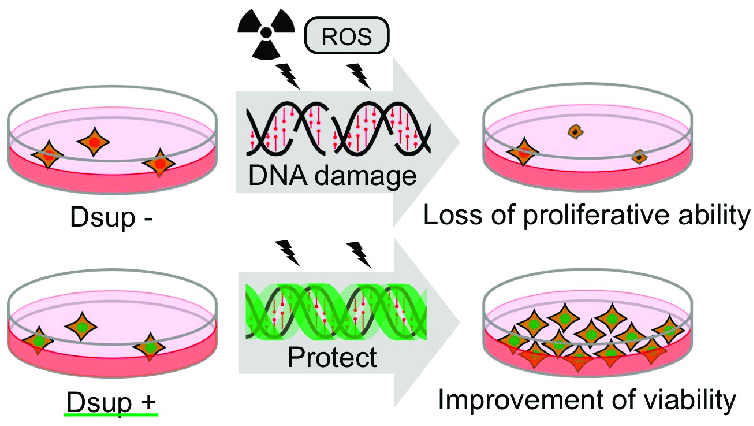What is a tardigrade?
Tardigrades, commonly known as “water bears”, are micro-animals that have plump bodies and eight stubby legs. Depending on the species, they range in size from 0.1 to 1.5 mm. They are covered in a tough cuticle, similar to the exoskeletons of grasshoppers, and have four to six claws on the end of their legs. These claws are made of chitin and they grab things to propel themselves forward. Their unique mouthpart is called a bucco pharyngeal apparatus, which allows them to extract nutrients from plants and microorganisms. Tardigrades do not have a respiratory system and instead, they exchange gas throughout their whole body. There are more than 1000 different tardigrade species and they all belong to an elite category of animals that can withstand just about any extreme condition. [6]

How tough are we talking about?
These little creatures can survive in some of the harshest environments from volcanoes to the deepest oceanic trench.
In 2007, thousands of tardigrades were attached to a satellite and blasted into space. If people were attached to a satellite and blasted into space without protection, the lack of pressure of the surrounding environment would suck out all the air in our lungs. Gases inside our body fluids would start to expand, pushing out the outer skin. Blood would start to boil and even if we had survived all that, ionizing radiation would tear apart the DNA in our cells. In other words, we would die. But tardigrades returned to Earth, having survived the conditions in outer space.
Aside from outer space, they were found surviving in the Himalayan mountains, in hot springs, at the bottom of the ocean and in Antarctica.
Why can they survive such environments?
A unique protein in their bodies is partially responsible for their resilience. The Dsup protein which is a short term for “damage suppressor”, protects the DNA from possible harm such as the ionizing radiation, which is present in soil, water, vegetation ,and in space. Biochemical approaches to study Dsup revealed that the protein binds with chromatin to protect the DNA from damage by the most powerful oxidizing agents. While there are remaining mysteries regarding tardigrades and the Dsup protein, it is clear that this protein allows the animal to live longer under normal or extreme environmental conditions.[1]

Another surviving tactic used by tardigrades is called cryptobiosis. This phenomenon is close to biological death and is also used by other living organisms. Tardigrades curl up into a dry husk commonly known as a “tun” as it shreds almost all the water in its body. They can stay in this state for decades, only reanimating when it comes to contact with water.
This process is possible due to a particular sugar called trehalose that stabilizes key components such as proteins and membranes, which otherwise would be destroyed. This sugar can also wrap around the remaining water molecules, stopping them from expanding if the temperature rises. [3]

The tun states make tardigrades indestructible. In the1920s, a friar named Gilbert Franz Rahm brought tardigrades in tun state back to life after heating them to 151°c for 15 minutes. Rahm also tested them in the cold. He immersed them in liquid air at -200°c for 21 months, in liquid nitrogen at -253°c for 26 hours, and in liquid helium at -272 °c for 8 hours. All tardigrades came back to life after becoming in contact with water.
While Dsup proteins protected them from radiation, tardigrades can actually tolerate ice forming within their cells. The trehalose sugar may also prevent the formation of large ice crystals that would pierce the membranes.
On the other hand, not much is known about their reason for resilience against heat.[3]
The given extreme conditions damage the DNA and other cells inside the tardigrade. Heat and cold cause proteins to unfold, stick together and stop working. Radiation tears up the DNA and other molecules. High pressure solidifies the fatty membranes around the cells. But because all of these stressors cause similar problems, the tardigrades only need a few survival tricks that provide overlapping solutions.
Possible applications
Tardigrades, being the most “immortal” animal according to current knowledge, gives us new possibilities that can be applied in the field of biotechnology. While cryptobiosis is unnecessary considering our superiority and intelligence as a living organism, the application of Dsup protein on humans can widen our opportunities.
Sources
[1]Chavez, Carolina, et al. “The Tardigrade Damage Suppressor Protein Binds to Nucleosomes and Protects DNA from Hydroxyl Radicals.” ELife, ELife Sciences Publications, Ltd, 1 Oct. 2019, elifesciences.org/articles/47682. Last Accessed: 25 Mar. 2021.
[2]Deaton, Jeremy. “What Is a Tardigrade?” NBCNews.com, NBCUniversal News Group, 14 Oct. 2019, www.nbcnews.com/mach/amp/ncna1065771. Last Accessed: 25 Mar. 2021.
[3]Fox-Skelly, Jasmin. “Earth – Tardigrades Return from the Dead.” BBC, BBC, 13 Mar. 2015, www.bbc.com/earth/story/20150313-the-toughest-animals-on-earth. Last Accessed: 25 Mar. 2021.
[4]Ktmoelle. “What Makes a Tardigrade?” Ktmoelle, 18 Feb. 2019, askabiologist.asu.edu/tardigrade-anatomy. Last Accessed: 25 Mar. 2021.
[5]“Proteomic Analysis of Tardigrades: Towards a Better Understanding of Molecular Mechanisms by Anhydrobiotic Organisms.” PLOS ONE, Public Library of Science, journals.plos.org/plosone/article/figure?id=10.1371%2Fjournal.pone.0009502.g001. Last Accessed: 25 Mar. 2021.
[6]“Tardigrade, Facts and Photos.” Animals, www.nationalgeographic.com/animals/invertebrates/facts/tardigrades-water-bears. Last Accessed: 25 Mar. 2021.
[7]Zachos, Elaina. New Species of Water Bear, or Tardigrade, Found in Japan Parking Lot. 10 Feb. 2021, www.nationalgeographic.com/animals/article/tardigrade-water-bear-parking-lot-japan-spd. Last Accessed: 25 Mar. 2021.
